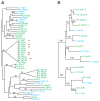Genomic analysis of organismal complexity in the multicellular green alga Volvox carteri
- PMID: 20616280
- PMCID: PMC2993248
- DOI: 10.1126/science.1188800
Genomic analysis of organismal complexity in the multicellular green alga Volvox carteri
Abstract
The multicellular green alga Volvox carteri and its morphologically diverse close relatives (the volvocine algae) are well suited for the investigation of the evolution of multicellularity and development. We sequenced the 138-mega-base pair genome of V. carteri and compared its approximately 14,500 predicted proteins to those of its unicellular relative Chlamydomonas reinhardtii. Despite fundamental differences in organismal complexity and life history, the two species have similar protein-coding potentials and few species-specific protein-coding gene predictions. Volvox is enriched in volvocine-algal-specific proteins, including those associated with an expanded and highly compartmentalized extracellular matrix. Our analysis shows that increases in organismal complexity can be associated with modifications of lineage-specific proteins rather than large-scale invention of protein-coding capacity.
Figures



Comment in
-
Genetics. Volvox genome shows it doesn't take much to be multicellular.Science. 2010 Jul 9;329(5988):128-9. doi: 10.1126/science.329.5988.128-a. Science. 2010. PMID: 20616240 No abstract available.
References
Publication types
MeSH terms
Substances
Grants and funding
LinkOut - more resources
Full Text Sources
Other Literature Sources
Molecular Biology Databases

